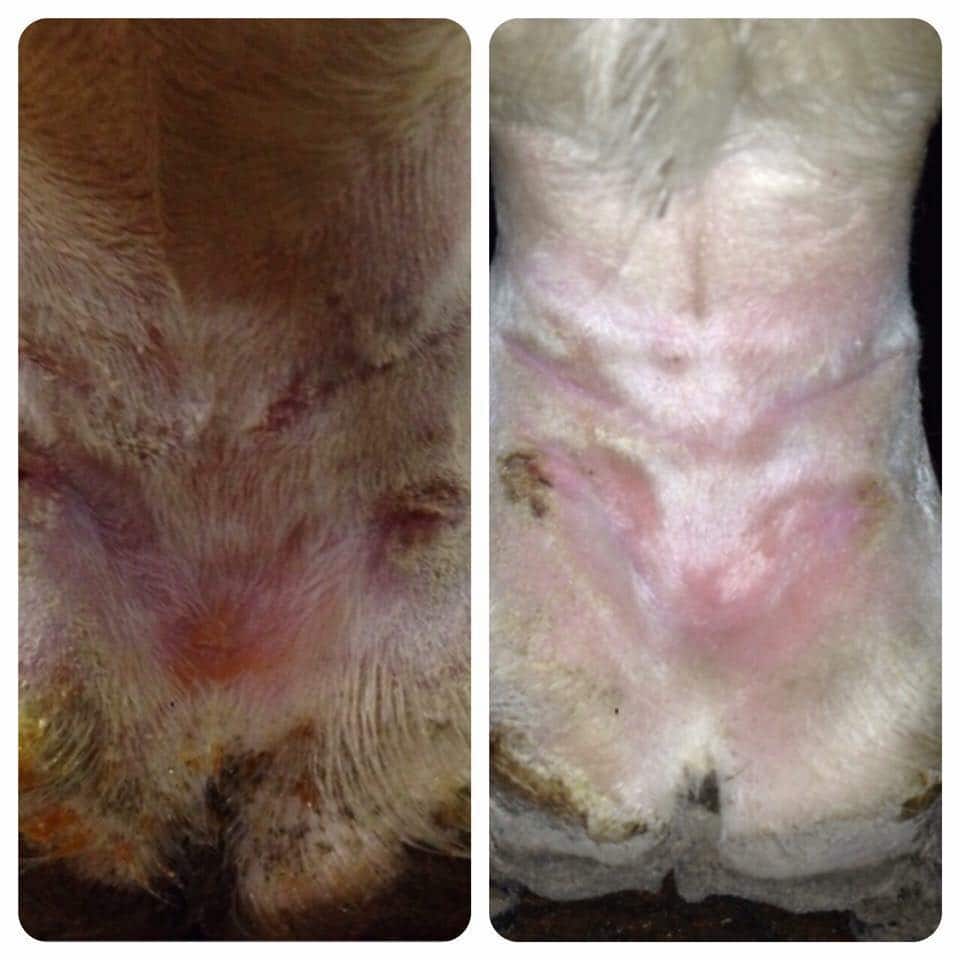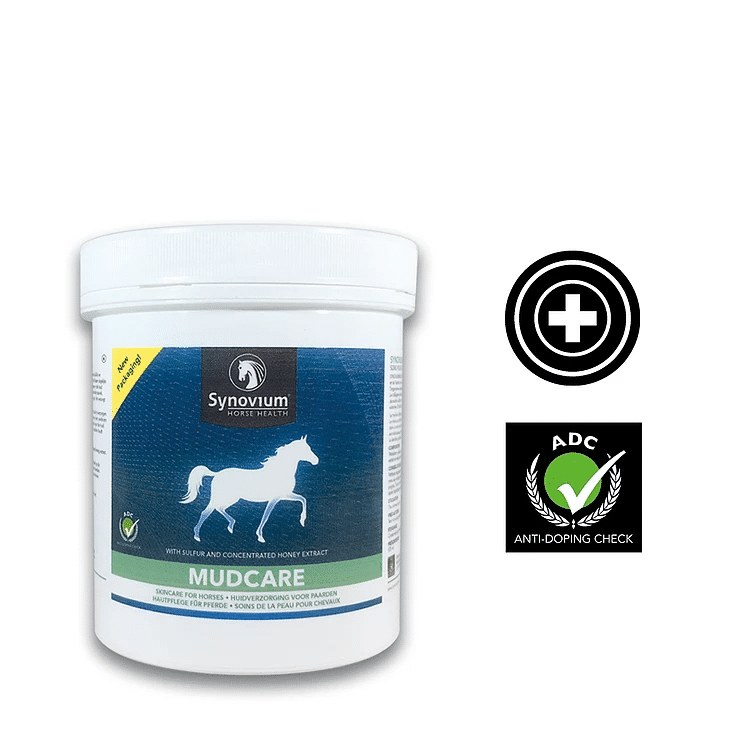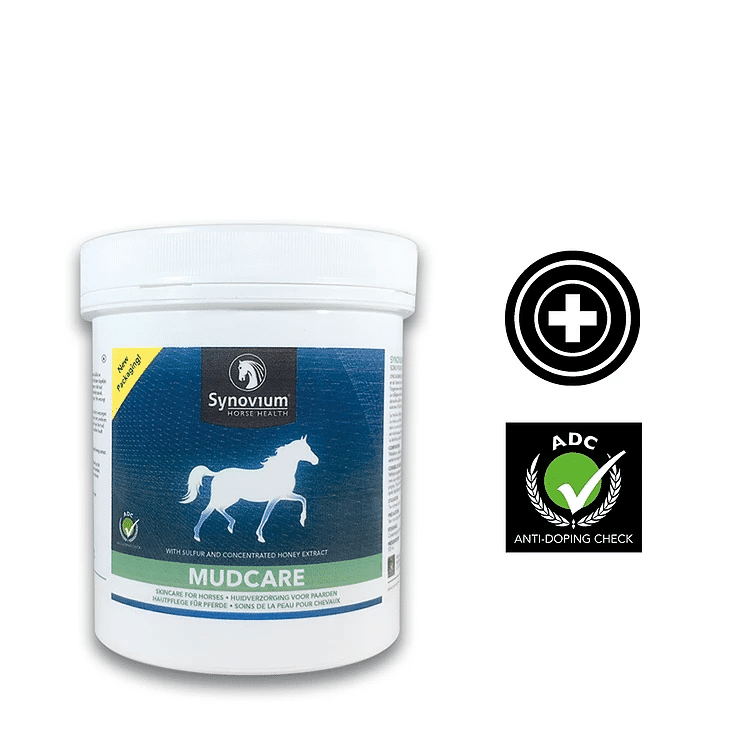
What is mud fever?
‘Mud Fever’, also known as pastern dermatitis, is a skin condition that causes irritation, soreness, and scabs with moist lesions underneath. Mud Fever is usually found on the back of the horse’s heels and the fetlocks, but it can extend up the back of the legs. Infections can develop underneath the scabs and you may notice heat and swelling. The horse may react when pressure is applied or with flexion of the affected limb. In severe cases, hair loss can occur leaving exposed inflamed skin which may split open. As with any bacterial infection, if left untreated Mud Fever can become more serious, very quickly. Infection can spread further up the leg. This level of damage to the skin can result in the open sores being difficult to heal. And in severe cases, skin grafts may be required.
Mud Fever is caused by the bacteria (Dermatophilus Congolensis), which thrives in muddy, wet conditions. It generally arises during Winter and early Spring; however, it can continue to cause problems all year. Healthy skin would normally act as a barrier, however in muddy and wet conditions, the upper layer of skin can become compromised. This is because the continual damp conditions cause the protective layer to fail, making it vulnerable to infection.
How do I prevent mud fever?
When it comes to Mud Fever prevention is key! Rotate the use of your paddocks to prevent them becoming badly churned up, as the bacteria are transmitted in the soil. Try to avoid your horse having to stand in deep mud by fencing high traffic areas such as gateways. Another preventative measure is to put down high quality hardcore in these areas to provide a standing surface and better drainage.
Refrain from washing off your horse’s legs when you bring him in. It is generally better to allow the mud to dry and then brush off with a soft bristled brush. If you must wash your horse’s legs, use a warm (never cold), clean water, and ensure you dry them thoroughly.
Use a specialised product such as Synovium® Mudcare to help protect the skin from moisture to help prevent Mud Fever. Mudcare contains Lanolin which works by keeping the skin flexible and moisture proof forming a protective layer between the leg and mud.
How do you treat mud fever?
In the unfortunate event that your horse does contract Mud Fever act fast! It is vital you keep him out of the mud and wet as much as possible.
For horses with thick feathers it is recommended to clip the hair away from the infected area. Clean the designated area using a warm dilute (0.1%) Hibiscrub solution, rinse it completely with warm, clean water. Removing the scabs helps the healing process because the bacteria thrives underneath them. Ensure you dry your horse’s legs thoroughly using a clean, dry, soft towel. Keeping your horse’s legs dry is crucial to treating Mud Fever successfully.
Once your horse’s legs are clean and dry, liberally apply a coat of barrier cream such as Synovium® Mudcare to the area.
If you can keep your horse in at night and cover the layer of barrier cream loosely in cling film. Cover with a clean, dry stable bandage and ensure your horse has clean, dry bedding.
If you are in any doubt, or the condition worsens contact your vet!
.

SYNOVIUM® MUDCARE is a firm favourite with our customers because it has a multitude of uses. Veterinary skin care containing a unique formula of sufficient sulfur and concentrated pure honey. Encourages optimum healing of the horse’s skin and damaged tissue. Can be applied to wounds, cuts, sores, and works wonders on skin conditions such as Mud Fever and Sweet itch!

Sulfur is present in tissues and is essential for healthy skin. It is an antiseptic, helping to kill bacteria and fungi on the skin. Collagen synthesis is essential to the structure of skin cells, and strongly depends on the availability of sufficient sulfur which is provided in Synovium Mudcare.
Honey has been used since ancient times for healing because it has a low pH-value; bacteria cannot survive in an acid environment. Honey contains small amounts of enzymes that help maintain a healthy skin and combat any irritation.
Lanolin keeps the skin flexible and moisture proof. Our formula has been uniquely developed by our team of vets to provide something you can rely on. A nourishing ointment that every horse owner needs in their tack room!

Synovium® Mudcare was recently featured in an exclusive interview for World of Showjumping. The worlds best grooms shared their top tips and tricks on Mud Fever, Madeleine Broek groom for Marc Houtzager, uses Mudcare on their fleet of horses and it is their top product to go to!
Read the interview here: https://www.worldofshowjumping.com/WoSJ-Exclusive-interviews/GoPro-part-seven-Tips-tricks-on-mud-fever-from-the-world-s-best-grooms.html
Click on the link to get yours today: https://www.synovium.co.uk/products/synovium-mudcare/

